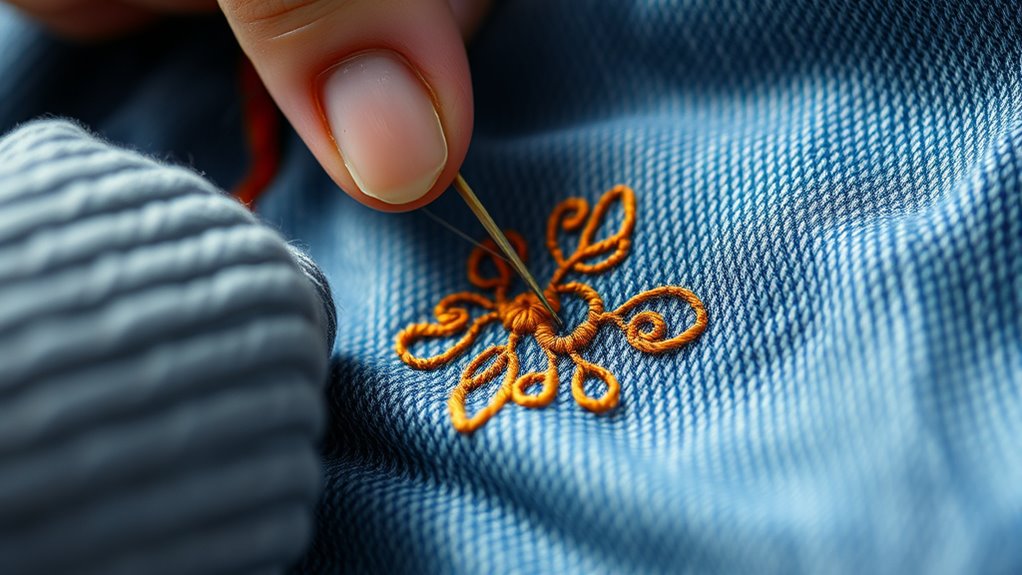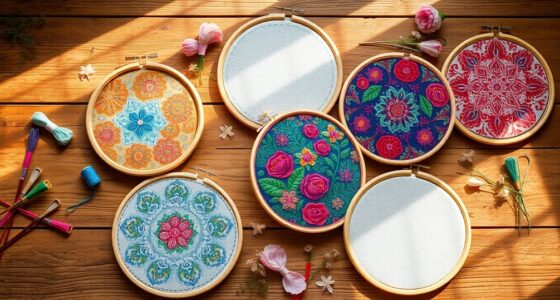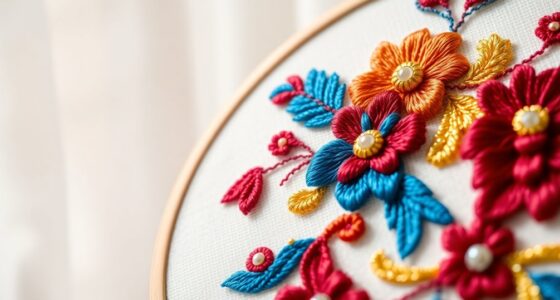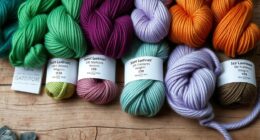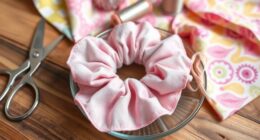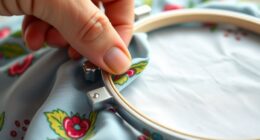When embroidering tricky fabrics like knits, denim, or silk, choosing the right stabilizer and needle is key. Use a cut-away stabilizer for delicate fabrics or tear-away for stretch materials. Select fine, sharp needles for silk or chiffon, and stretch or universal needles for knits. Support your fabric with adhesive stabilizers and test your settings on scraps first. Keep tension adjusted and remove stabilizer gently to protect the fabric. To master these techniques, explore more helpful tips below.
Key Takeaways
- Select appropriate stabilizers: use cut-away for delicate fabrics, tear-away for stretch knits, and extra support for denim.
- Choose the right needle: sharp or universal needles for dense fabrics like denim, and stretch or ballpoint needles for knits.
- Test on scrap fabric to determine optimal stabilizer, needle, and tension settings before embroidery.
- Use adhesive stabilizers or hoops to keep fabric flat and prevent shifting during stitching.
- Adjust tension slightly and remove stabilizer gently to avoid puckering or fabric damage.
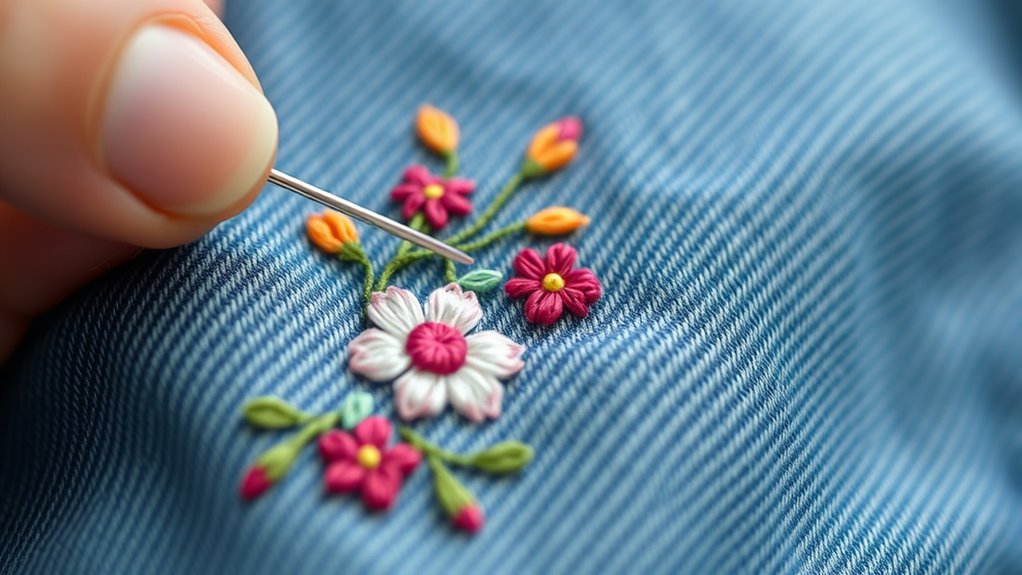
Have you ever struggled to embroider on difficult fabrics like silk, velvet, or stretchy knits? If so, you’re not alone. These tricky materials can be a challenge because they tend to shift, stretch, or snag during stitching. The key to successful embroidery on such fabrics lies in proper stabilizer selection and choosing the right needle types. Stabilizers provide the necessary support to keep your fabric stable and prevent puckering or distortion. For delicate fabrics like silk or velvet, a light, cut-away stabilizer often works best because it offers support without adding bulk. On stretch fabrics like knits, a tear-away stabilizer can stabilize the stitches while allowing for easy removal after stitching. The type of stabilizer you pick should match the fabric’s weight and stretchiness to ensure the design stays crisp and the fabric remains undamaged. Additionally, using a spray adhesive or temporary fabric adhesive can help keep the fabric flat and prevent shifting during embroidery, especially on slippery or silky materials. The type of stabilizer you pick should match the fabric’s weight and stretchiness to ensure the design stays crisp and the fabric remains undamaged.
Equally important is selecting the correct needle type. For delicate fabrics such as silk or chiffon, a fine, sharp needle like a size 60/8 or 70/10 is ideal. These needles pierce the fabric cleanly, reducing the risk of snags or pulls. When working on velvet or plush materials, a universal or sharp sewing needle can help penetrate the dense pile smoothly. For stretchy knits, a stretch or ballpoint needle is your best bet. These needles have a rounded tip that slides between the fabric fibers rather than piercing through them, preventing runs or skipped stitches. Using the wrong needle can cause skipped stitches, fabric damage, or puckering, which is why needle choice is critical. Be mindful that ear wax odor can sometimes be confused with other odors, so always assess your environment and materials carefully to avoid misinterpretation. Additionally, consider how the stabilizer interacts with your fabric and machine tension. You might need to adjust your tension settings slightly when working with more delicate or stretchy fabrics. Test on scrap pieces first to find the perfect combination of stabilizer, needle, and tension. Remember, the goal is to keep the fabric stable without restricting its natural drape or stretch. If you’re embroidering on velvet or silk, use a hoop or adhesive stabilizer for extra support, but be gentle when removing it afterward to avoid damaging the fabric.
Frequently Asked Questions
Can I Machine Wash Embroidered Tricky Fabrics Without Damage?
Yes, you can machine wash embroidered tricky fabrics without damage if you follow proper fabric care. Use a gentle cycle and cold water to protect the embroidery durability. Turn the garment inside out to reduce friction, and avoid harsh detergents. Air dry or tumble dry on low heat. These steps help preserve your embroidery and keep the fabric looking its best, ensuring your stitched design stays intact longer.
What Types of Needles Work Best on Difficult Textiles?
You should use the right needle size and type for difficult textiles. For knits, choose a stretch or ballpoint needle size 70/10 or 75/11 to avoid damaging fibers. For denim or heavy fabrics, opt for a denim or sharp needle size 90/14 or 100/16. These specialized needles help prevent skipped stitches and fabric snags, making embroidery smoother and more professional-looking on tricky materials.
How Do I Prevent Puckering When Embroidering on Stretchy Fabrics?
Think of your fabric like a delicate dance partner; to prevent puckering, choose a stable stabilizer tailored for stretch fabrics, like tear-away or cut-away. Adjust your stitch tension slightly lower to keep stitches smooth and flexible. Always test on a scrap first, ensuring your machine’s settings balance tension and stabilizer. This way, your embroidery flows seamlessly, capturing the beauty of your stretchy fabric without puckers or distortions.
Is Special Thread Necessary for Embroidery on Rough or Textured Surfaces?
You don’t necessarily need special thread for textured surfaces, but it can help. Regular embroidery thread might catch or fray on rough or uneven fabrics. Using a stronger, thicker, or more durable thread—like polyester or metallic—can improve your results and prevent breakage. For best results, match your thread type to the texture, and consider stabilizing the fabric well to keep stitches smooth and secure on those challenging surfaces.
Can I Use Standard Embroidery Hoops on Thick or Layered Fabrics?
Using standard embroidery hoops on thick or layered fabrics is like trying to fit a square peg in a round hole. You’ll want a larger hoop size to accommodate the extra layers without distorting fabric tension. This prevents puckering and keeps your stitches even. For best results, choose a hoop that securely holds your fabric without excessive pressure, ensuring your embroidery stays smooth and professional-looking.
Conclusion
Now that you know how to tackle tricky fabrics like knits and denim, are you ready to bring your creative visions to life? With these tips, you’ll turn challenging textures into stunning embroidery masterpieces. Remember, patience and preparation are your best friends. So, next time you pick up that stubborn fabric, ask yourself: what beautiful detail will you add today? Trust in your skills, and let your stitches tell your unique story.
